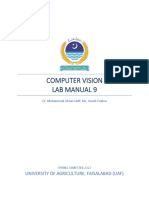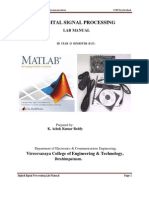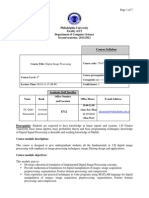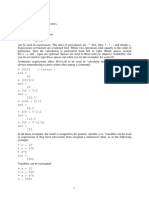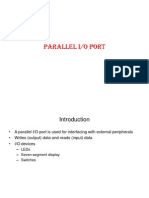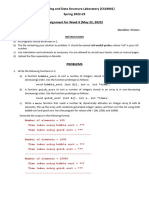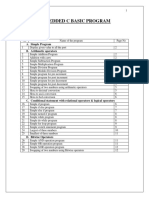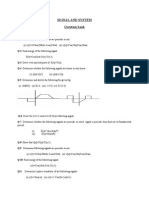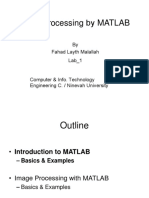MATLAB for Image Processing
CS638-1 TA: Tuo Wang tuowang@cs.wisc.edu Feb 12th, 2010
�Outline
Introduction to MATLAB
Basics & Examples
Image Processing with MATLAB
Basics & Examples
�What is MATLAB?
MATLAB = Matrix Laboratory MATLAB is a high-level language and interactive environment that enables you to perform computationally intensive tasks faster than with traditional programming languages such as C, C++ and Fortran. (www.mathworks.com)
MATLAB is an interactive, interpreted language that is designed for fast numerical matrix calculations
�The MATLAB Environment
MATLAB window components:
Workspace
> Displays all the defined variables
Command Window
> To execute commands in the MATLAB environment
Command History
> Displays record of the commands used
File Editor Window > Define your functions
�MATLAB Help
MATLAB Help is an extremely powerful assistance to learning MATLAB
Help not only contains the theoretical background, but also shows demos for implementation
MATLAB Help can be opened by using the HELP pull-down menu
�MATLAB Help (cont.)
Any command description can be found by typing the command in the search field As shown above, the command to take square root (sqrt) is searched We can also utilize MATLAB Help from the command window as shown
�More about the Workspace
who, whos current variables in the workspace save save workspace variables to *.mat file load load variables from *.mat file clear clear workspace variables - CODE
�Matrices in MATLAB
Matrix is the main MATLAB data type How to build a matrix?
A=[1 2 3; 4 5 6; 7 8 9]; Creates matrix A of size 3 x 3
Special matrices:
zeros(n,m), ones(n,m), eye(n,m), rand(), randn()
�Basic Operations on Matrices
All operators in MATLAB are defined on matrices: +, -, *, /, ^, sqrt, sin, cos, etc. Element-wise operators defined with a preceding dot: .*, ./, .^ size(A) size vector sum(A) columns sums vector sum(sum(A)) sum of all the elements - CODE
�Variable Name in Matlab
Variable naming rules
- must be unique in the first 63 characters
- must begin with a letter - may not contain blank spaces or other types of punctuation
- may contain any combination of letters, digits, and underscores
- are case-sensitive - should not use Matlab keyword
Pre-defined variable names pi
�Logical Operators
==, <, >, (not equal) ~=, (not) ~ find(condition) Returns indexes of As elements that satisfy the condition
�Logical Operators (cont.)
Example: >>A=[7 3 5; 6 2 1], Idx=find(A<4)
A=
7 3 5 6 2 1
Idx=
3 4 6
�Flow Control
MATLAB has five flow control constructs:
if statement switch statement for loop while loop break statement
�if
IF statement condition
The general form of the IF statement is
IF expression
statements
ELSEIF expression
statements
ELSE
statements
END
CODE
�switch
SWITCH Switch among several cases based on expression The general form of SWITCH statement is:
SWITCH switch_expr
CASE case_expr,
statement, , statement
CASE {case_expr1, case_expr2, case_expr3, }
statement, , statement
OTHERWISE
statement, , statement
END
�switch (cont.)
Note:
Only the statements between the matching CASE and the next CASE, OTHERWISE, or END are executed Unlike C, the SWITCH statement does not fall through (so BREAKs are unnecessary)
CODE
�for
FOR repeats statements a specific number of times The general form of a FOR statement is:
FOR variable=expr
statements
END
CODE
�while
WHILE repeats statements an indefinite number of times The general form of a WHILE statement is:
WHILE expression
statements
END
CODE
�Scripts and Functions
There are two kinds of M-files:
Scripts, which do not accept input arguments or return output arguments. They operate on data in the workspace Functions, which can accept input arguments and return output arguments. Internal variables are local to the function
�Functions in MATLAB (cont.)
Example: A file called STAT.M: function [mean, stdev]=stat(x) %STAT Interesting statistics. n=length(x); mean=sum(x)/n; stdev=sqrt(sum((x-mean).^2)/n); Defines a new function called STAT that calculates the mean and standard deviation of a vector. Function name and file name should be the SAME!
CODE
�Visualization and Graphics
plot(x,y),plot(x,sin(x)) plot 1D function figure, figure(k) open a new figure hold on, hold off refreshing axis([xmin xmax ymin ymax]) change axes title(figure titile) add title to figure mesh(x_ax,y_ax,z_mat) view surface contour(z_mat) view z as topo map subplot(3,1,2) locate several plots in figure
- CODE and Debug CODE
�Saving your Work
save mysession
% creates mysession.mat with all variables save mysession a b
% save only variables a and b clear all % clear all variables clear a b % clear variables a and b load mysession % load session
�Outline
Introduction to MATLAB
Basics & Examples
Image Processing with MATLAB
Basics & Examples
�What is the Image Processing Toolbox?
The Image Processing Toolbox is a collection of functions that extend the capabilities of the MATLABs numeric computing environment. The toolbox supports a wide range of image processing operations, including:
Geometric operations Neighborhood and block operations Linear filtering and filter design Transforms Image analysis and enhancement Binary image operations Region of interest operations
�Images in MATLAB
MATLAB can import/export several image formats:
BMP (Microsoft Windows Bitmap) GIF (Graphics Interchange Files) HDF (Hierarchical Data Format) JPEG (Joint Photographic Experts Group) PCX (Paintbrush) PNG (Portable Network Graphics) TIFF (Tagged Image File Format) XWD (X Window Dump) raw-data and other types of image data
Data types in MATLAB
Double (64-bit double-precision floating point) Single (32-bit single-precision floating point) Int32 (32-bit signed integer) Int16 (16-bit signed integer) Int8 (8-bit signed integer) Uint32 (32-bit unsigned integer) Uint16 (16-bit unsigned integer) Uint8 (8-bit unsigned integer)
�Images in MATLAB
Binary images : {0,1} Intensity images : [0,1] or uint8, double etc. RGB images : m n 3 Multidimensional images: m n p (p is the number of layers)
�Image Import and Export
Read and write images in Matlab img = imread('apple.jpg'); dim = size(img); figure; imshow(img); imwrite(img, 'output.bmp', 'bmp'); Alternatives to imshow imagesc(I) imtool(I) image(I)
�Images and Matrices
How to build a matrix (or image)? Intensity Image:
Row 1 to 256 o Column 1 to 256 [256, 256] [0, 0]
row = 256; col = 256; img = zeros(row, col); img(100:105, :) = 0.5; img(:, 100:105) = 1; figure; imshow(img);
�Images and Matrices
Binary Image:
row = 256; col = 256; img = rand(row, col); img = round(img); figure; imshow(img);
�Image Display
image - create and display image object imagesc - scale and display as image imshow - display image colorbar - display colorbar getimage - get image data from axes truesize - adjust display size of image zoom - zoom in and zoom out of 2D plot
�Image Conversion
gray2ind - intensity image to index image im2bw - image to binary im2double - image to double precision im2uint8 - image to 8-bit unsigned integers im2uint16 - image to 16-bit unsigned integers ind2gray - indexed image to intensity image mat2gray - matrix to intensity image rgb2gray - RGB image to grayscale rgb2ind - RGB image to indexed image
�Image Operations
RGB image to gray image Image resize Image crop Image rotate Image histogram Image histogram equalization Image DCT/IDCT Convolution
- CODE
�Outline
Introduction to MATLAB
Basics & Examples
Image Processing with MATLAB
Basics & Examples
�Examples working with Images (1/3)
Create AVI movie with a series images
Video
�Examples working with Images (2/3)
Blending two images
�Examples working with Images (3/3)
Sobel descriptor to detect object edge
�Performance Issues
The idea: MATLAB is
very fast on vector and matrix operations Correspondingly slow with loops
Try to avoid loops Try to vectorize your code
http://www.mathworks.com/support/technotes/1100/1109.html
�Vectorize Loops
Example Given image matrices, A and B, of the same size (540*380), blend these two images apple = imread(apple.jpg'); orange = imread(orange.jpg); Poor Style
% measure performance using stopwatch timer tic for i = 1 : size(apple, 1) for j = 1 : size(apple, 2) for k = 1 : size(apple, 3) output(i, j, k) = (apple(i, j, k) + orange(i, j, k))/2; end end end toc
Elapsed time is 0.138116 seconds
�Vectorize Loops (cont.)
Example
Given image matrices, A and B, of the same size (600*400), blend these two images apple = imread(apple.jpg'); orange = imread(orange.jpg);
Better Style
tic % measure performance using stopwatch timer Output = (apple + orange)/2; toc
Elapsed time is 0.099802 seconds
Computation is faster!
�THE END
Thanks for your attention! Questions?










